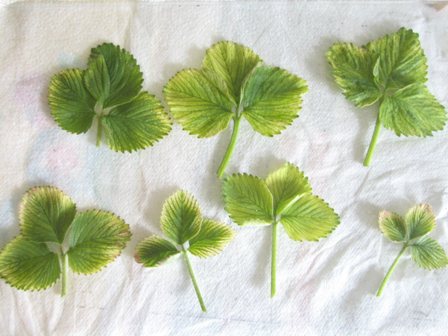Iron Chlorosis Of Fruit Crops
With the excessive precipitation in spring and saturated soil conditions there will be more incidence of iron chlorosis in fruit crops. Although iron is an abundant trace element in soil, plants may have difficulty in absorbing enough when soils are saturated with water. Typically iron deficiency chlorosis is a common problem in fruit trees and certain ornamental and shelterbelt species in high lime calcareous or heavy clay soils. Other conditions which can induce iron deficiency include high soil pH (alkalinity), excess phosphate in soil, along with low soil temperature, and excess quantities of copper and manganese in acid soils. Iron is a catalyst to chlorophyll formation in leaves of the plant.

Symptoms
The first symptom is a gradual yellowing of the tissue between the veins on younger leaves while the veins themselves tend to stay green. If unchecked this condition may advance throughout the plant causing the tips and margins of some leaves to turn brown and become dry and brittle. In severe cases the leaves can become so chlorotic that the leaves appear almost white. The leaf tissue is then so delicate that it easily scorches in wind or sun. This may reduce fruit yields as resources required for fruit production may be reduced. Sometimes one portion of a plant or perhaps a few trees in an area or patch of plants may be affected. It is also possible to have an affected tree plant and a healthy plant of the same species growing side by side. In severe cases, entire plants can lose their leaves and die.
Treatment
When chlorosis is caused by saturated soils, the condition should be reduced when the soil dries out. If soils remain saturated, the first treatment (foliar sprays) suggested below may be the best solution. However, keep in mind that saturated soils stress root systems and are more susceptible to root rot and other diseases. Because of the complex nature of iron availability, treatments are not always successful. However, there are several treatments to choose from.
- Foliar sprays - at the onset of symptoms spray leaves with a ferrous sulphate solution. Spray as a very fine mist. If the treatment is successful the plants should begin to green up about 10 days after spraying. Foliar applications are a temporary measure and successive treatment may be applied. This treatment may be the best solution with chlorosis caused by saturated soils.
- Soil application of iron chelates - Apply iron chelates to the soil in the early spring by working them into the top 3 to 5 cm of soil around the base of the tree and watering well. Iron chelates are available from most garden centres. Soil application of iron chelates is the most effective treatment for chlorosis. Results, while not immediate, should last for one to two seasons. This treatment is more effective in soil types that typically cause chlorosis (high lime calcareous or heavy clay soils).
Prevention
If the condition is due to saturated soil conditions, providing good surface and internal drainage may reduce incidence of chlorosis. When the condition is known to persist in an area (i.e. caused by high lime calcareous or heavy clay soils), then susceptible plants such as raspberries, currants, apples, high bush cranberries should not be planted.
